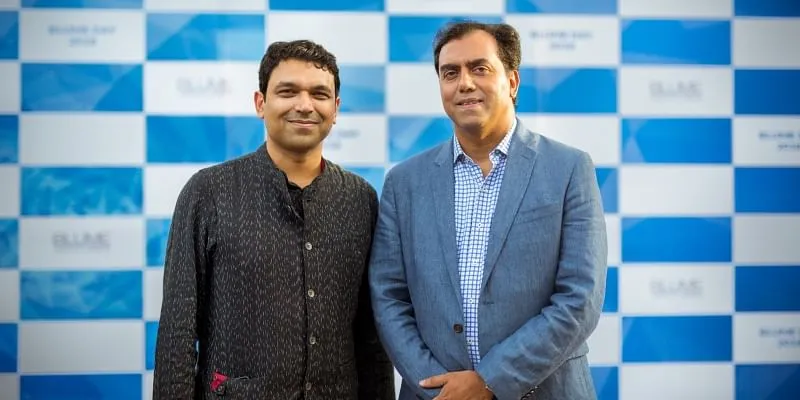10 years of Blume Ventures: How a homegrown VC redefined early-stage startup financing in India
Blume Ventures started in 2010 to bridge the gap between small angel investors and giant VCs. In the last decade, it has backed hordes of startups that have become household names, mirroring the growth of India’s digital economy.
In February, just before the coronavirus pandemic peaked, Blume Ventures announced the close of its third fund at $102 million. This is the first time a homegrown venture capital firm has raised a Fund III, or secured a corpus of over $100 million.
For the latest fund, like in Fund II ($60 million), Blume roped in international institutional investors or Limited Partners (LPs), and some corporate and family offices to raise a majority of the corpus. Fund I ($20 million), however, was raised entirely from domestic HNIs.

Karthik Reddy (L) and Sanjay Nath, Co-founders and Managing Partners, Blume Ventures
Everyone wants a bigger cheque today. With the evolution of VC investing, the explosion of India’s mobile-led digital economy, and second-time founders in the ecosystem, round sizes have gone up.
VCs too need more dry powder to prevent dilution of their opening stakes when portfolio startups go on to raise larger rounds.
Hence, Blume, which completed a decade in July, turned to LPs and international investors for Fund III, and also closed a $41 million Opportunity Fund to further invest in its successful bets (mostly growth-stage startups).
“LPs back you when they know that you can become a story of [many] successes,” Sanjay Nath, Co-founder and Managing Partner of Blume Ventures, tells YourStory.
And it wouldn’t be an exaggeration to call Blume ‘a story of many successes’.

Blume Ventures has elevated Ashish Fafadia (centre) as Partner for Fund III
Founded in 2010 by Karthik Reddy and Sanjay Nath, Blume launched its first fund in 2011, becoming India’s first institutionalised early-stage investor at a time when startup funding lay with angels or giant VCs like Sequoia Capital and Tiger Global.
Blume bridged the fundamental gap between the two by thinking like an early-stage angel investor — sometimes backing even idea-stage startups — but approaching the association like an institutional VC. They followed up the funding with continuous mentoring, and services like hiring, business development, go-to-market, and so on.
Sanjay says, “We were a micro VC when we began, and became more institutionalised through the years. It takes 10 years to build a village, they say.”
Summing up a decade
Blume’s decade-long journey mirrors the staggering growth of India’s internet economy.
Many of the 145+ startups it has backed over the years have gone on to become household names: , , , (exited post a $200-million sale to Ola in 2015), , , , , , , and others.
With 22 exits, over 75 active portfolio startups, and $225 million in capital managed, it is one of India’s most prolific and trusted VCs today.

Infographic: Tenzin Pema
Jasminder Singh Gulati, Co-founder and CEO of (a Blume-funded startup acquired by Reliance in 2019), tells YourStory,
“Blume believed in the India story. They went with their gut and invested in early-stage teams. In those days [2013], VC money was less, and founders weren’t prepared as they are today on the cap table. They came with an idea as opposed to a full-fledged product with traction. Karthik bet on our B2C product, which later pivoted to B2B SaaS. It was a great testament of Blume’s trust in us taking the right turn. They always had that ability to nurture.”
“Many investors dropped off and moved on, but Blume continued to remain on the table. And even now, after they have exited, I continue to speak to the team once a week,” ‘Jas’ (as he’s called by Blumiers) adds.

Photo: YS Design
Does Blume have any big misses or regrets from the last 10 years?
Not really, says Karthik, adding, “There may have been companies in our portfolio that failed, but we don’t see it as a miss.”
He goes on to share,
“, , , — they were a lot different when pitched to us. Either we weren’t fully convinced or we had something competing in our portfolio. But, none of these companies has offered exits; they are just fat unicorns. With Freshworks, we got close, but they were raising rounds we couldn't control... Companies will keep getting missed, but you regret losing out on the founder relationships.”
Despite the glowing tributes marking Blume’s 10th anniversary, both Sanjay and Karthik know that the next decade is going to look very different from the previous one. Fund III is possibly its first step in that direction. (more on that later)
The genesis of Blume Ventures
Karthik and Sanjay met at Mumbai Angels (a 300-member collective of angel investors) in the late-2000s, after returning from the US, having earned their MBA degrees from Wharton and UCLA respectively, and dabbling in financial markets in the Silicon Valley.
Between 2007 and 2010, Karthik got a ringside view of VC investing during his time as the VP of Brand Capital (strategic investment arm of Times Group).
Sanjay, meanwhile, was a member at Mumbai Angels and TiE. He backed a few startups, and even wrote a “small cheque” for InMobi in 2006. InMobi went on to become India's first unicorn, and a global name.
While at Mumbai Angels, the two connected in the strangest of ways. “We were introduced by folks saying, both of you are thinking of an early-stage [fund], so you should talk,” recalled Karthik, in an earlier conversation.

Portfolio founders and team at Blume Day 2019
The duo launched Blume in 2010, and by 2011, had raised Rs 100 crore (about $20 million) to set up Fund I.
Karthik reveals,
“We had no Valley connection, and were the first ones to do that. There were other homegrown funds, of course. Vani [Kola] set up Kalaari [Capital]; there was Helion [Venture Partners] and Nexus [Venture Partners], but they had some or the other Valley linkage. We wanted to build a fund ground-up, and one that would outlast us.”
Karthik and Sanjay divided their duties neatly. The former led the consumer-facing verticals from edtech to ecommerce to mobility, while the latter focused on B2B tech, SaaS, and deeptech, or what Blume calls, “built in India for global markets”.
On being asked if the notion of him being the “hard guy” was true, Karthik said, “I’m cut-and-dried in terms of decision making. Sanjay is an enabler and loves consensus building. What we are proud of in Blume is that every team member brings the right blend of soft and hard when it comes to entrepreneurs. We know where to mix it up.”

Blume 20/20 message printed on tees | Photo - Blume
Fund I-II-III: the evolution
Between 2011 and 2015, Blume’s Fund I invested in about 70 startups. The average cheque size ranged from $250,000 to $500,000, and would go up to $750,000 to $1 million at the most. The VC would take a minimum of 20 percent equity and add value in terms of mentoring, hiring, and support till the Series B-C rounds.
The stars of its Fund I portfolio included Grey Orange (robotics startup for warehouse automation), Instamojo (multichannel payment gateway for SMEs) and TaxiForSure (ride-hailing service acquired by Ola, which gave Blume one of its biggest exits).
In 2016, the VC launched Fund II, which was 3X the size of its predecessor. As the demand for capital increased, and the number of funds and angels — both domestic and international — exploded, the $500,000 seed cheque became $1-1.5 million in what came to be known as the ‘Pre-Series A’ round.

Unacademy is one of the breakout stars in Blume's Fund II portfolio
Sanjay shares, “We started specialising in the second fund, and increased the focus on consumer verticals. We also became more thesis-driven and institutional.”
Fund II, which invested from 2016 to 2018, saw many growth-stage breakouts, including Unacademy, Dunzo, Milkbasket, , HealthifyMe, among others.
Blume became increasingly convinced about sectors like edtech, fintech, and healthcare. “Karthik sort of saw them as the ‘roti, kapda, makaan’ for Fund II,” Sajith Pai, Director, Blume Ventures, explained in a recent podcast, adding, “I think his conviction primarily came from the theme of a computer in every pocket.”
By 2018, startups in India began to get more vertical-focused. The country’s ‘Jiofication’ was also in full force, and hundreds of millions of first-time users were flocking to the internet, opening up large markets for niche startups. The year also brought about the domestic startup economy’s watershed moment. Until Walmart’s multibillion-dollar acquisition of Flipkart in 2018, “exits were always a problem”.

TaxiForSure (which was acquired by Ola) was one of Blume's biggest exits.
Karthik explains, “There were no poster children until then. had gone public, yes. But a $100-200 million exit seemed like a commendable achievement. When the story played out, things changed dramatically. Unicorns started forming, imagination started expanding, and founders knew that a billion-dollar company could be formed in India.”
Towards the end of 2018, Blume began to raise Fund III with a target corpus of $80 million. That drew to a close at $102 million in 2020.
With several repeat founders entering the ecosystem with ever-expanding round sizes, equity dilutions have become brutal for early-stage investors. So, Blume is budgeting cheques of $3-5 million for its Fund III portfolio.
Karthik says,
“Repeat founders like Ashish Kashyap, Kunal Shah, Mukesh Bansal, who’ve built success stories before, don’t have to go through seed, A, B rounds. They club all three rounds into one. The lens has shifted. Investors are buying into a rockstar founder or an already established relationship. But we are looking at seed + pre-series A + A rounds. Founders are looking at us to validate their product.”
New funds and the future of investing
Since 2014, Blume has maintained a 60:40 split between domestic and global in its portfolio. That has culminated into Arka Venture Labs, an accelerator for cross border B2B startups. The Silicon Valley-based fund is a joint venture among Blume Ventures, Benhamou Global Ventures, and Emergent Ventures.

Blume launched Arka Venture Labs (a cross border accelerator) in a JV with US funds
Sanjay, who’s a founding partner-member of Arka, says, “Selling has changed now. Zoho, Freshworks, Postman, and other SaaS companies have proven that you can start and build anywhere in the world. You can be based in Belgrade, Barcelona or Bangalore, but we’re looking at a founder’s ability to have the vision to move their APIs to the world. With Postman [the hottest unicorn story of 2020], you can see that vision.”
Blume believes that after SaaS, deeptech could go global from India. “It is a very important sector, and we need one local superhero to emerge in either robotics or AI/ML. Can the likes of Grey Orange or Tricog Health, take their full-stack platforms global and create plug-and-play solutions like Postman did?” Sanjay asks.
As Blume enters its next decade, it is looking at a more “broad-based sectoral strategy”. Thematically, it focuses on three segments: B2C for India, B2B for global, and B2B for SMEs/kiranas. It also has multiple theses and sub-theses across sectors.
Sanjay explains, “If we have a thesis on spacetech, for instance, we’ll have a sub-thesis on drone tech too. Similarly, we have a thesis on autonomous vehicles under mobility, robotics under deeptech, etc.”
Other sunrise sectors like edtech, agritech, cleantech, biotech, and healthtech are also gaining ground in the VC landscape. Over the last year, Blume’s Fund III has invested in Classplus and LeverageEdu in edtech; LambdaTest in SaaS; Procol, and Jai Kisan in agritech and farm financing; Turtlemint in fintech; Agara Labs in deeptech; HealthAssure in healthtech; TapChief and Skillenza in HR tech, and more.

Blume believes that after SaaS, deeptech could go global from India
Mumbai-headquartered Blume is also growing its presence across cities. Last year, it opened two new offices in Delhi and Bengaluru, and is hiring in these locations. By 2024, the VC wants to have a fifth fund, with $500 million under management.
But gone are the days when VCs backed only ideas and teams without caring much about the product-market fit. Even though there’s more capital at disposal, burn without a business model is unwelcome, especially in the wake of the coronavirus pandemic.
Karthik shares,
“A top-down push is happening now. Exit strategies, whether you sell or get listed, are becoming important. There is ample pressure on VCs to show that an IPO is possible. The larger the fund size, the larger the outcomes you are playing for.”
“LPs need to know that the market has proven something,” Sanjay adds.
Right now, of course, the VC’s only goal is to ensure that portfolio companies sail past these turbulent times with moral support, financial support, and all other kinds of guidance and mentoring. Blume, which calls itself “a collection of all our founders”, is doing just that. Its daily Zoom webinars with founders since the lockdown began have almost become the talk of startup street.
Karthik sums up by saying, “Behavioural change is not trivial, and the pandemic has brought about that at an unforeseen pace. The momentum will continue, and the market will be big enough to support three to four winners in every sub-sector.”
Edited by Saheli Sen Gupta












